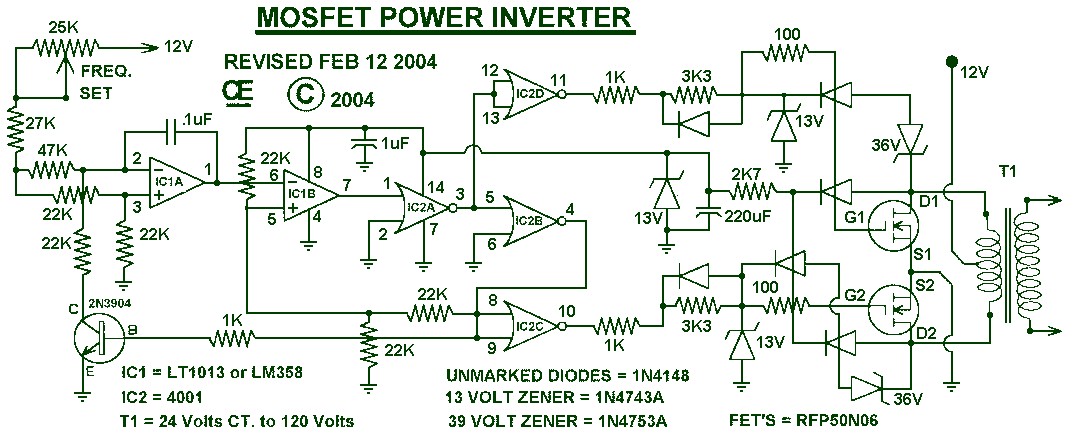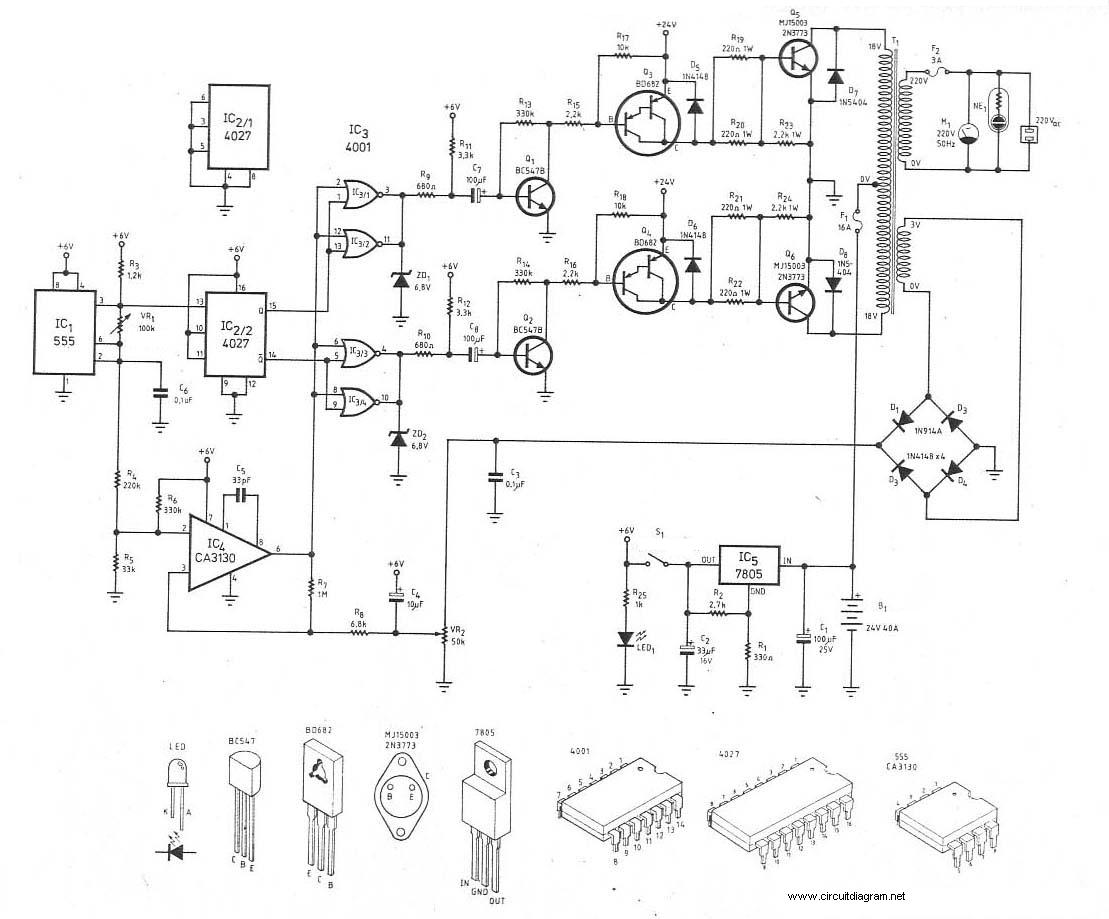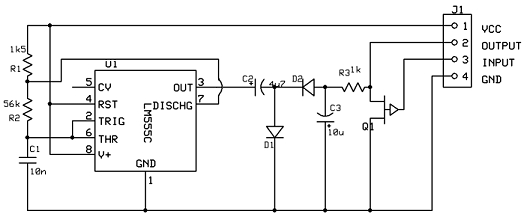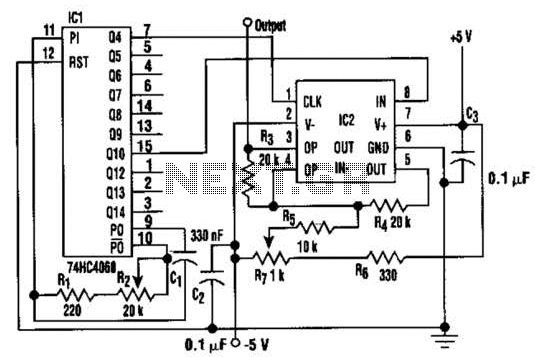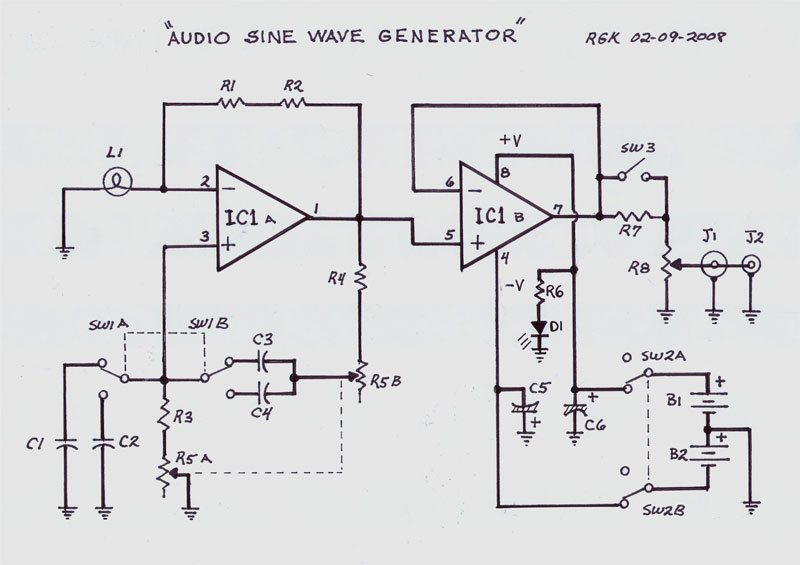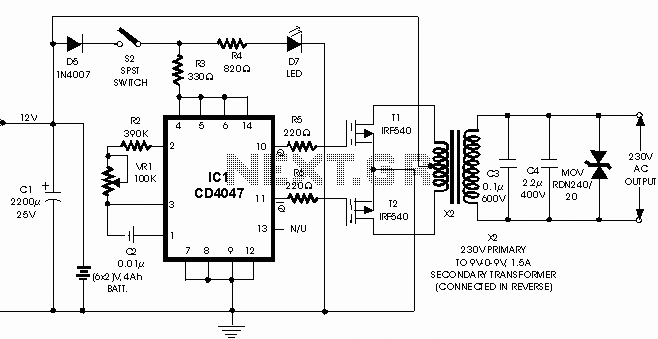
12VDC to 220VAC Inverter with Sine Wave Output
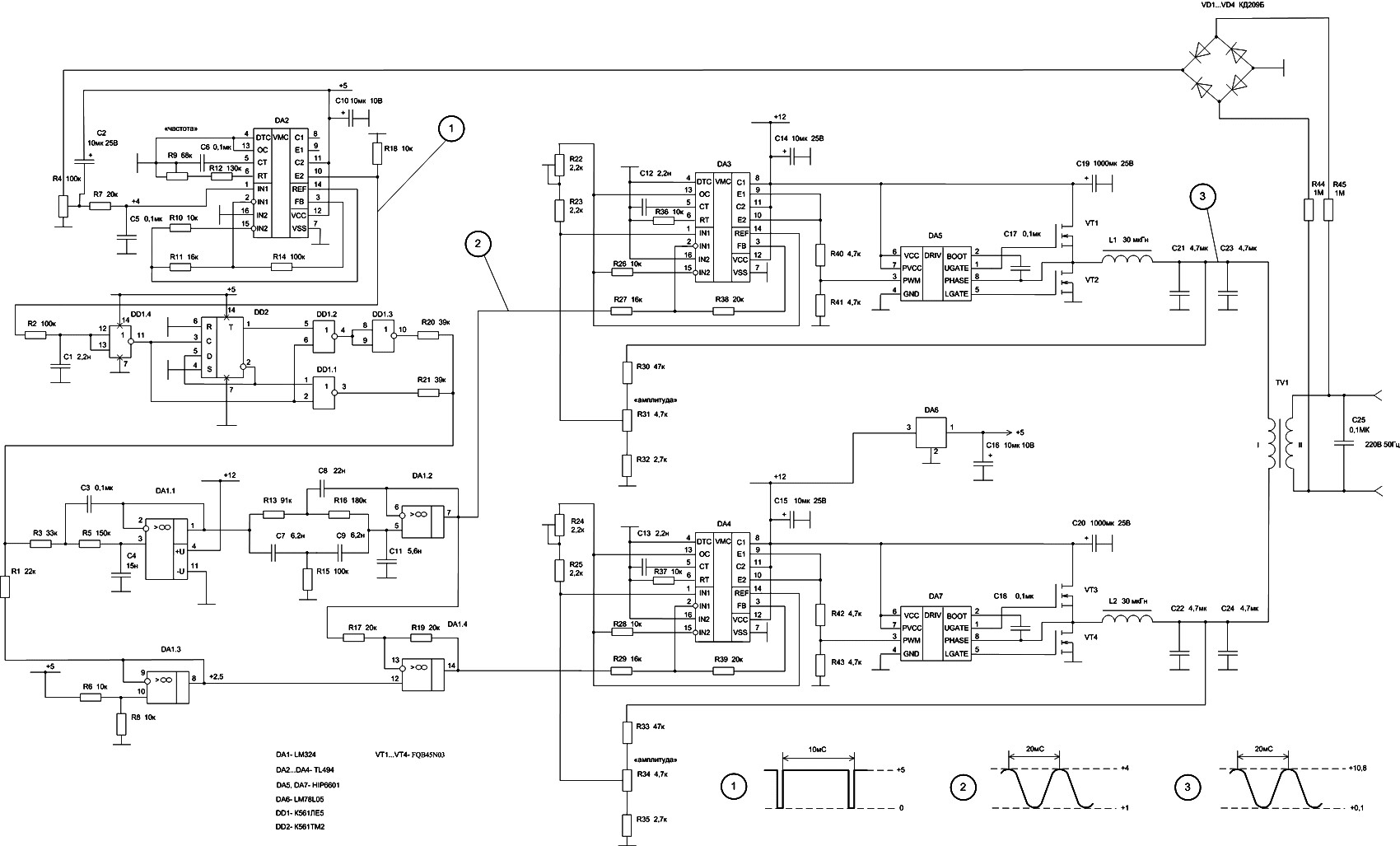
The 50W inverter circuit is built using the power MOSFET FQB45N03 and the IC TL494. This inverter converts a 12-14V DC input from a car battery into a 220V AC output with a 50Hz sine wave frequency. The main oscillator, along with a voltage reference and comparator, is integrated into the DA2 section. External components DD1 and DD2 replicate the internal functions. This modified sine wave inverter operates at a frequency rate of 50Hz, providing a 240V AC output. Powered by two pieces of power MOSFETs STP55NF06L, the inverter can deliver up to 500W of power. The PIC16F628A microcontroller is programmed to generate a logic 5V signal for 5ms and then turn off for 15ms at pin 17. Additionally, there is a schematic diagram for a 100W inverter circuit that converts a 12V DC input to a 220V AC output. This circuit is based on the IC CD4047, which generates a 50Hz sine wave signal. The power transistor 2N3055 boosts the signal to achieve higher power and current levels. Furthermore, the 150W Tripp Lite portable inverter converts a 12V DC input from a car battery into a 120V AC output, utilizing the vehicle's battery to power personal electronics, making it an ideal solution for mobile professionals and travelers. This simple DC to AC converter consists of no more than 12 components. The IC CD4047 generates a signal with a frequency of 50/60Hz, with phase outputs on pins 10 and 11 fed to the gates of MOSFET transistors IRFZ44. These transistors alternately switch the primary winding of the transformer, producing the desired output.
The inverter circuit described operates by utilizing a combination of power MOSFETs and control ICs to effectively convert DC voltage into AC voltage. The FQB45N03 MOSFET is known for its high efficiency and fast switching capabilities, making it suitable for inverter applications. The TL494 IC serves as the heart of the control system, providing necessary feedback and regulation to maintain stable output voltage and frequency.
In the design, the DA2 section integrates the oscillator, voltage reference, and comparator functions to ensure precise control over the output waveform. The external components DD1 and DD2 are crucial for replicating the internal circuit behavior, enhancing the overall performance of the inverter.
The use of two STP55NF06L MOSFETs allows the inverter to handle significant power loads, up to 500W, making it capable of powering various devices. The inclusion of the PIC16F628A microcontroller adds programmability, allowing for customized control over the inverter's operation.
The schematic for the 100W inverter circuit highlights the use of the CD4047 IC, which is well-regarded for generating stable sine wave signals. The 2N3055 power transistor amplifies this signal to a level suitable for driving loads. This design is particularly beneficial for users needing a reliable power source for electronic devices in remote locations.
The Tripp Lite portable inverter exemplifies practical applications of such circuits, providing a versatile solution for converting vehicle battery power to AC power for personal electronics. Its compact design and minimal component count make it an attractive option for users on the go. The use of IRFZ44 MOSFETs in the design allows for efficient switching, ensuring that the inverter operates smoothly while delivering the necessary power output.
Overall, these inverter designs represent a blend of efficiency, simplicity, and versatility, catering to a wide range of applications in mobile power solutions.Here the 50W inverter circuit build based power MOSFET FQB45N03 and IC TL494. This inverter will convert 12-14V DC input from car battery, become 220V AC output with 50Hz sine wave frequency. The main oscillator, a voltage reference and comparator collected on DA2. External elements DD1 and DD2 repeated internal. This Modified Sine Wave Inverter frequency rate is 50Hz, give you 240V AC output. Powered by the 2 pieces of power MOSFETs STP55NF06L, the inverter capable to deliver up to 500W power. The PIC16F628A is programmed to produce a logic 5v signal for 5ms at pin 17 then 15ms off. . Here the schematic diagram of 100W Inverter Circuit which will convert 12VDC input to be 220VAC output.
The circuit built based IC CD4047 to generate sine wave signal 50Hz and then the power transistor 2N3055 will boost the signal so that the signal have high power (high electric current). Then. This is the 150W Tripp Lite portable inverter and it will convert the 12VDC input from car battery power source to become 120VAC output.
The inverter taps the power of your vehicle`s battery to power your personal electronics ”wherever life takes you. It`s the ideal power solution for mobile professionals, travelers. This DC to AC converter is very simple and contains no more than 12 components. IC CD4047 generates a signal with frequency 50/60Hz, who paraphase exits 10 and 11 is fed to the gates of MOSFET transistors IRFZ44.
Transistors alternately commute primary winding of the transformer floor, and appears on. We aim to transmit more information by carrying articles. Please send us an E-mail to wanghuali@hqew. net within 15 days if we are involved in the problems of article content, copyright or other problems. We will delete it soon. 🔗 External reference
The inverter circuit described operates by utilizing a combination of power MOSFETs and control ICs to effectively convert DC voltage into AC voltage. The FQB45N03 MOSFET is known for its high efficiency and fast switching capabilities, making it suitable for inverter applications. The TL494 IC serves as the heart of the control system, providing necessary feedback and regulation to maintain stable output voltage and frequency.
In the design, the DA2 section integrates the oscillator, voltage reference, and comparator functions to ensure precise control over the output waveform. The external components DD1 and DD2 are crucial for replicating the internal circuit behavior, enhancing the overall performance of the inverter.
The use of two STP55NF06L MOSFETs allows the inverter to handle significant power loads, up to 500W, making it capable of powering various devices. The inclusion of the PIC16F628A microcontroller adds programmability, allowing for customized control over the inverter's operation.
The schematic for the 100W inverter circuit highlights the use of the CD4047 IC, which is well-regarded for generating stable sine wave signals. The 2N3055 power transistor amplifies this signal to a level suitable for driving loads. This design is particularly beneficial for users needing a reliable power source for electronic devices in remote locations.
The Tripp Lite portable inverter exemplifies practical applications of such circuits, providing a versatile solution for converting vehicle battery power to AC power for personal electronics. Its compact design and minimal component count make it an attractive option for users on the go. The use of IRFZ44 MOSFETs in the design allows for efficient switching, ensuring that the inverter operates smoothly while delivering the necessary power output.
Overall, these inverter designs represent a blend of efficiency, simplicity, and versatility, catering to a wide range of applications in mobile power solutions.Here the 50W inverter circuit build based power MOSFET FQB45N03 and IC TL494. This inverter will convert 12-14V DC input from car battery, become 220V AC output with 50Hz sine wave frequency. The main oscillator, a voltage reference and comparator collected on DA2. External elements DD1 and DD2 repeated internal. This Modified Sine Wave Inverter frequency rate is 50Hz, give you 240V AC output. Powered by the 2 pieces of power MOSFETs STP55NF06L, the inverter capable to deliver up to 500W power. The PIC16F628A is programmed to produce a logic 5v signal for 5ms at pin 17 then 15ms off. . Here the schematic diagram of 100W Inverter Circuit which will convert 12VDC input to be 220VAC output.
The circuit built based IC CD4047 to generate sine wave signal 50Hz and then the power transistor 2N3055 will boost the signal so that the signal have high power (high electric current). Then. This is the 150W Tripp Lite portable inverter and it will convert the 12VDC input from car battery power source to become 120VAC output.
The inverter taps the power of your vehicle`s battery to power your personal electronics ”wherever life takes you. It`s the ideal power solution for mobile professionals, travelers. This DC to AC converter is very simple and contains no more than 12 components. IC CD4047 generates a signal with frequency 50/60Hz, who paraphase exits 10 and 11 is fed to the gates of MOSFET transistors IRFZ44.
Transistors alternately commute primary winding of the transformer floor, and appears on. We aim to transmit more information by carrying articles. Please send us an E-mail to wanghuali@hqew. net within 15 days if we are involved in the problems of article content, copyright or other problems. We will delete it soon. 🔗 External reference
